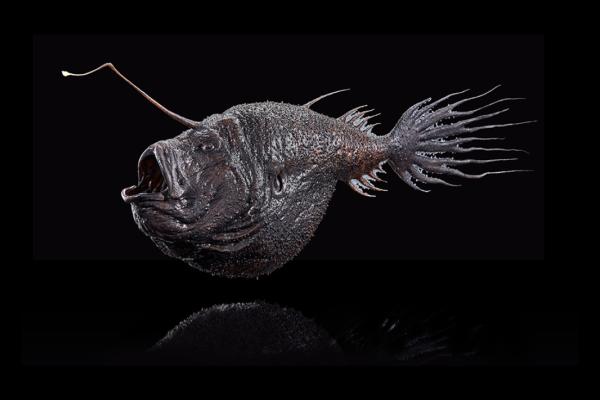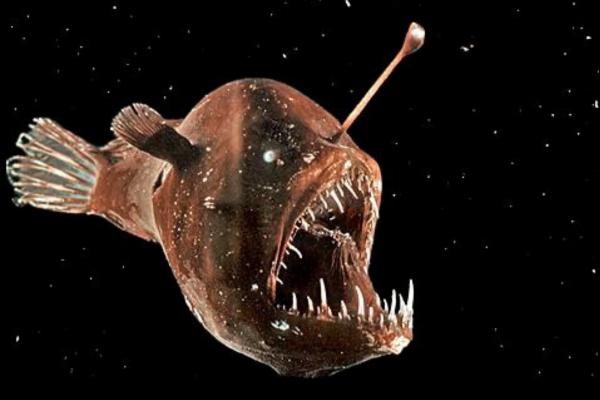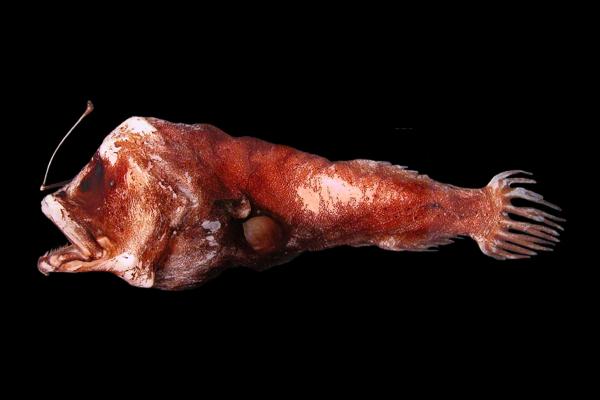Among the bizarre and mysterious creatures of the deep sea, few are as fascinating—and terrifying—as the lanternfish (Centrophryne spinulosa). Unlike many colorful, playful-looking fish, the lanternfish stands out for its massive head, needle-like teeth, and glowing lure, making it resemble a creature straight out of a horror film.
In this article, we dive deep into the anatomy, bioluminescence, habitat, diet, reproduction, and unique behaviors of the lanternfish—one of the most specialized predators in the deep ocean.

The term "lanternfish" doesn't refer to a single species, but rather to a diverse group of deep-sea fish within the taxonomic order Lophiiformes (anglerfish). They are ambush predators that rely on stealth and deception to survive in the pitch-black depths of the ocean.
Only females have the “lantern”: The “lantern” is a modified first dorsal fin spine that is not used for swimming, but rather acts as a bioluminescent lure.
The lure is positioned on the head: Located above the eyes or closer to the mouth (depending on the species), this glowing appendage is shaped to mimic prey and attract other animals.
Curved, inward-facing teeth: These trap prey once inside the mouth, preventing escape.
Highly flexible body: Allows the lanternfish to swallow prey up to twice its own size.
Extreme sexual dimorphism: Males are significantly smaller than females and lack functional jaws for feeding.
Males parasitize females: Males attach themselves to females temporarily or permanently, digesting the female’s skin with enzymes and fusing with her circulatory system to draw nutrients and reproduce.
The “lantern” at the end of the spine is equipped with a bioluminescent organ, which emits light through the help of symbiotic bacteria that produce light via chemical reactions. These bacteria are not inherited, but acquired from the environment.
This is a classic example of mutualistic symbiosis: the bacteria receive nutrients and a safe environment, while the fish gains a glowing lure to attract prey in the darkness of the deep sea.

Lanternfish species can be found in two main types of deep-sea environments:
Live close to the seafloor, often partially buried in sand or mud.
Their bodies are flattened dorsoventrally, making them appear almost flat—perfect for camouflage.
Their upward-facing mouths help capture prey that swims above.
Inhabit the open water column, sometimes at depths greater than 4,000 meters (13,000 feet).
These fish are laterally compressed or round-bodied and adapted to float and swim in deep, dark waters.
Despite the diversity, all lanternfish species are adapted to the abyssal zone, where sunlight is nonexistent and pressure is extreme.
Lanternfish are ambush predators. Using their bioluminescent lure, they attract unsuspecting prey toward their mouth. Once close enough, the lanternfish opens its jaws rapidly, creating a vacuum effect that sucks prey in—a method called suction feeding.
Shrimp and crustaceans
Small fish
Snails and other mollusks
Cephalopods, such as squid and octopus
Occasionally, larger prey that the fish can swallow thanks to its extendable body
Their feeding efficiency makes them dominant predators in the deep-sea food web.

Due to the sparse population density in the deep sea, mating opportunities are rare. As a result, some species have evolved extraordinary reproductive strategies.
Males are tiny compared to females and lack the ability to hunt or feed.
When a male finds a female, he releases enzymes that dissolve her skin, allowing him to fuse with her body.
They share a circulatory system, with the male drawing nutrients directly from the female.
A single female may carry up to six males simultaneously.
Once attached, reproductive organs mature, and both release sperm and eggs into the water—external fertilization.
Eggs develop independently, with no parental care.
Here are some extraordinary facts that make lanternfish truly one of a kind:
Male lanternfish lack immune genes that would normally reject foreign tissue—this allows them to fuse with females without triggering immune rejection.
Multiple males can parasitize a single female, forming a reproductive cluster.
The common anglerfish (often sold in seafood markets) is a close relative of the lanternfish, scientifically known as Lophius piscatorius.
The largest species, Ceratias holboelli, can grow up to 1.2 meters (nearly 4 feet) in length—massive for a deep-sea anglerfish.
Lanternfish play a critical role in deep-sea ecosystems, both as predators and prey for larger animals like whales and deep-diving sharks.
The lanternfish is a shining example of nature’s ingenuity—literally and figuratively. With its bioluminescent lure, elastic body, bizarre reproductive strategies, and terrifying appearance, it is one of the most fascinating animals of the deep sea.
These creatures may dwell in total darkness, but their evolutionary adaptations make them stand out as some of the most impressive and alien-like species on the planet.
Want to learn more about deep-sea creatures like the lanternfish? Explore our “Wild Animals” section to uncover the mysteries of the deep ocean.
Bibliografía
Tory A. Hendry, Lindsay L. Freed, Dana Fader, Danté Fenolio, Tracey T. Sutton, Jose V. Lopez, Nancy A. Moran. (2018). Ongoing Transposon-Mediated Genome Reduction in the Luminous Bacterial Symbionts of Deep-Sea Ceratioid Anglerfishes. Disponible en: https://journals.asm.org/doi/abs/10.1128/mBio.01033-18
The Great Barrier Reef Library. (2018). Lophiiformes. Disponible en: http://thegreatbarrierreeflibrary.org/lophiiformes/
Quigley, Declan. (2014). Ceratoid Anglerfishes (Lophiiformes: Ceratioidei) in Irish Waters. Sherkin Comment. 58. 7.
Bray, D.J. 2020, Anglerfishes, LOPHIIFORMES in Fishes of Australia. Disponible en: https://fishesofaustralia.net.au/home/order/25
animal tags: Lanternfish
We created this article in conjunction with AI technology, then made sure it was fact-checked and edited by a Animals Top editor.